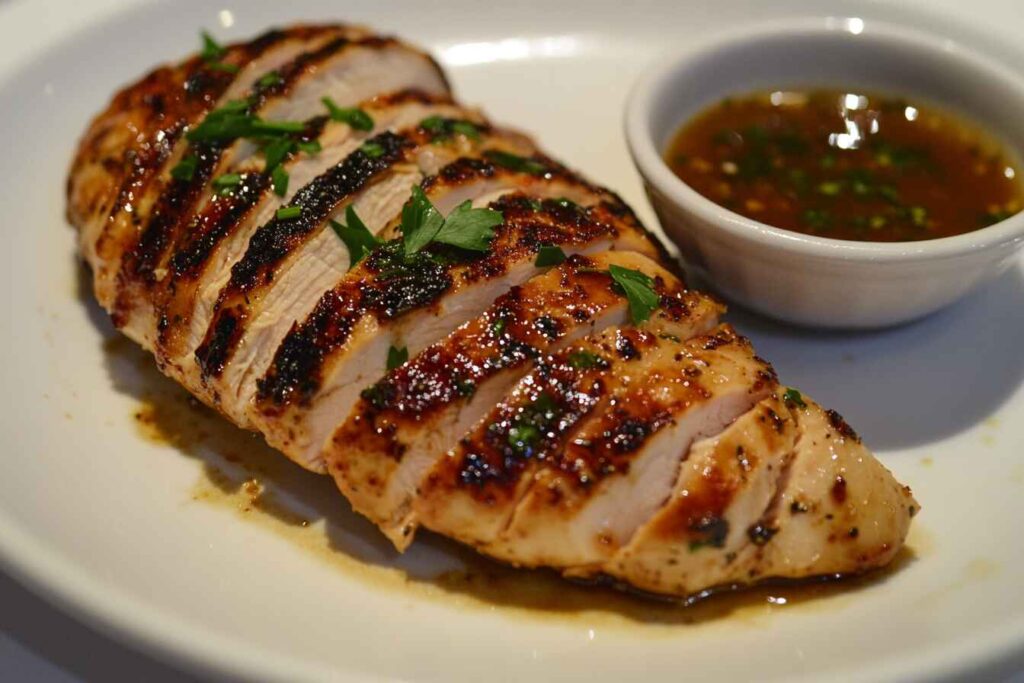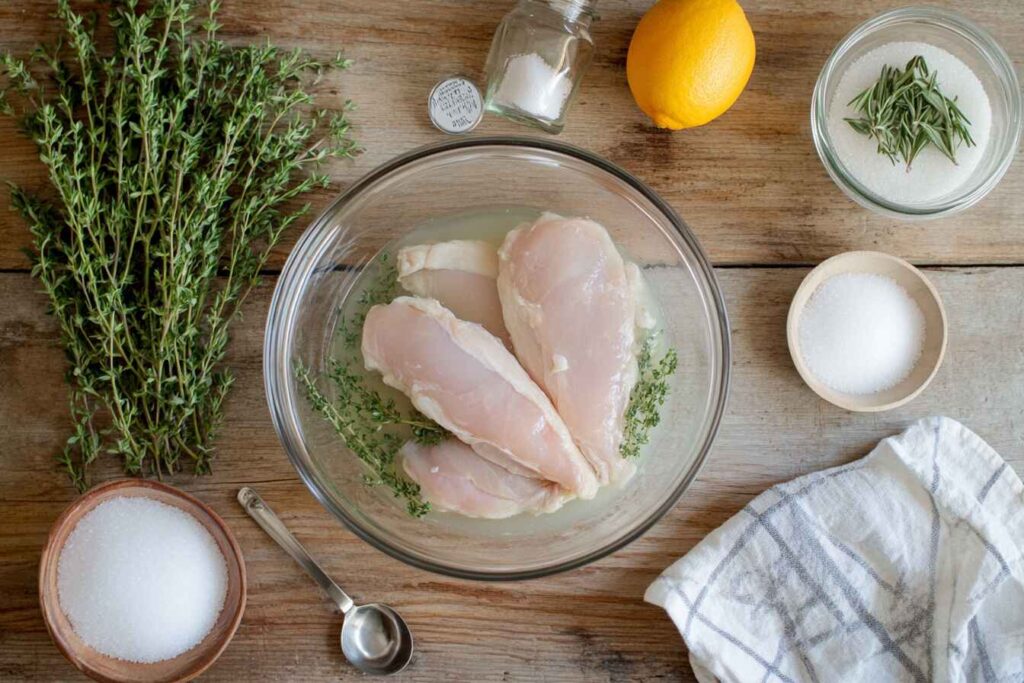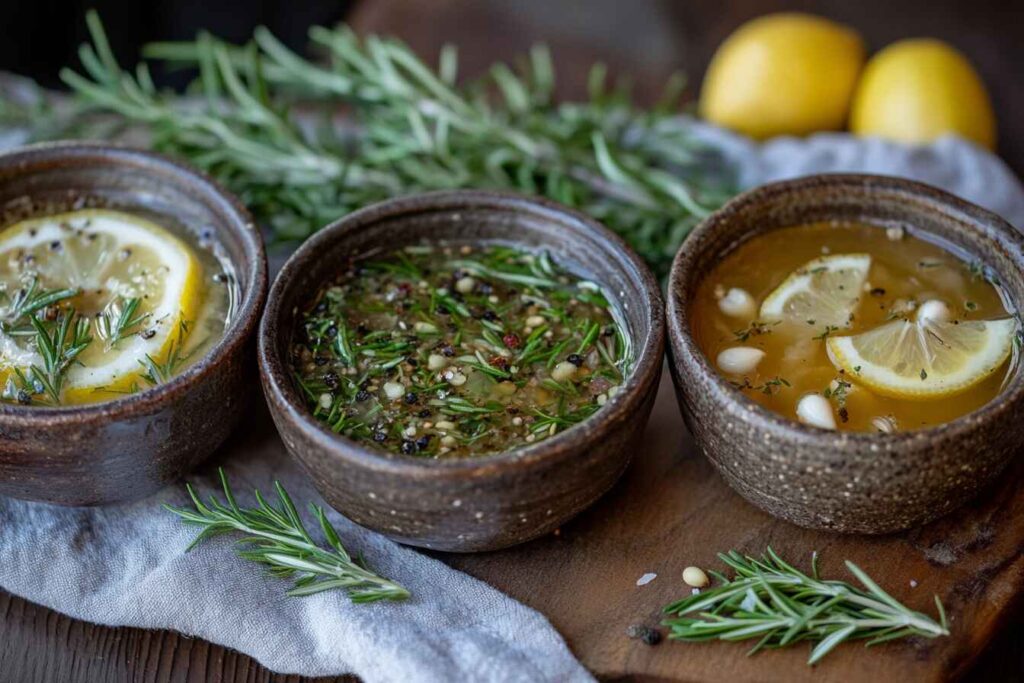Introduction

Have you ever taken a bite of chicken breast and found it dry, bland, or just downright disappointing? Don’t worry—you’re not alone! Brine Chicken breast is one of the trickiest proteins to cook perfectly because it can dry out so easily. But what if I told you there’s a simple trick to fix all of that? That trick is brining!
Brining is like giving your chicken breast a spa day—it soaks in a flavorful bath, absorbs moisture, and comes out tasting juicy and tender. Whether you’re grilling, baking, or pan-searing your chicken, brining is a game-changer.
In this article, I’m going to take you step-by-step through the process of brining chicken breast, explore its benefits, tackle common mistakes, and answer some burning questions. Ready to turn your chicken game around? Let’s dive in!
What Is Brining?
The Science Behind Brining
Let’s start with the basics—what exactly is brining? Brining is the process of soaking chicken (or any protein) in a saltwater solution. But it’s not just about dunking your chicken in water and hoping for the best. There’s some science behind it!
When you submerge chicken breast in a brine, the salt changes the protein structure in the meat. This allows the chicken to hold onto more water, even during cooking. The result? Moist, flavorful chicken that doesn’t dry out. Think of it as the difference between biting into a dry sponge and a juicy peach.
Why Brine Chicken Breast?
So, why should you brine chicken breast in the first place? Because chicken breast is naturally lean, it doesn’t have much fat to keep it juicy during cooking. Brining solves this by adding both moisture and flavor.
Here’s what happens:
- The saltwater gets absorbed into the chicken.
- The meat becomes tender because the salt breaks down muscle fibers.
- When you cook the chicken, it stays moist and flavorful instead of drying out.
Common Myths About Brining
There’s a lot of confusion when it comes to brining, so let’s clear the air.
- Myth 1: Brining makes your chicken salty.
Truth: If done correctly, brining adds just the right amount of seasoning without making it overly salty. - Myth 2: You need fancy ingredients to brine.
Truth: All you need is water and salt! Everything else is optional. - Myth 3: Brining takes too long.
Truth: You can brine chicken breasts in as little as 30 minutes for great results.
Benefits of Brining Chicken Breast
Improved Moisture and Juiciness
Have you ever wondered why restaurant chicken is always so juicy? The secret is brining! By soaking the chicken in a saltwater solution, it locks in moisture. Even if you accidentally cook the chicken a little too long, brining gives you a safety net to keep it from drying out.
Enhanced Flavor
Brining isn’t just about moisture—it’s also about flavor. The saltwater solution acts like a flavor delivery system, infusing the chicken with seasoning from the inside out. And the best part? You can customize your brine with herbs, spices, and even citrus for a unique twist.
How It Helps Avoid Overcooking
One of the biggest fears when cooking chicken breast is overcooking it. With brining, you have more wiggle room. The added moisture from the brine ensures that your chicken stays tender, even if you leave it on the grill or in the oven for a little too long.
Pro Tip: Always use a meat thermometer to check your chicken’s internal temperature. Aim for 165°F for perfectly cooked chicken!
How to Brine Chicken Breast: Step-by-Step Guide
Ingredients Needed

Here’s what you’ll need to get started:
| Ingredient | Quantity |
|---|---|
| Water | 4 cups |
| Kosher salt | ¼ cup |
| Sugar (optional) | 2 tbsp |
| Herbs and spices | To taste |
| Chicken breasts | 2-4 pieces |
Preparation Tips
- Choose the Right Container: Use a large, food-safe container or a resealable plastic bag. Make sure it’s big enough to submerge the chicken completely.
- Use Kosher Salt: Regular table salt is too fine and can make the brine overly salty. Stick to kosher salt for the best results.
- Don’t Skip the Rinse: After brining, rinse the chicken briefly to remove excess salt from the surface.
Step-by-Step Brining Process
- Mix the Brine: Combine water, salt, and sugar (if using) in a large bowl. Stir until fully dissolved.
- Add Flavor Boosters: Toss in herbs, spices, or aromatics like garlic, rosemary, or lemon slices for extra flavor.
- Submerge the Chicken: Place the chicken breasts into the brine, ensuring they’re fully covered.
- Let It Soak: Refrigerate the container for at least 30 minutes or up to 4 hours, depending on how much time you have.
- Rinse and Dry: After brining, rinse the chicken under cold water and pat it dry with paper towels.
Pro Tip: If you’re in a hurry, use warm water to dissolve the salt faster. Just make sure the brine cools before adding the chicken.
How Long Should You Brine Chicken Breast?
- Quick Brine: 30 minutes for a subtle improvement.
- Standard Brine: 1-2 hours for optimal juiciness and flavor.
- Long Brine: Up to 4 hours for the most tender results.
Be careful not to over-brine—leaving the chicken in the solution for too long can make it overly salty or mushy.
Mistakes to Avoid When Brining Chicken Breast
Brining is straightforward, but a few common mistakes can ruin your results. Let’s tackle those pitfalls so you can nail it every time.
Over-Brining: How to Avoid Salty Chicken
Brining chicken for too long can make it overly salty or mushy. Remember, chicken breast doesn’t need more than 4 hours in the brine.
- Solution: Set a timer and stick to the recommended brining time. If you accidentally over-brine, rinse the chicken thoroughly and soak it in plain water for 30 minutes to remove some of the excess salt.
Choosing the Wrong Salt
Not all salts are the same. Table salt is too fine, so it dissolves differently and can make your brine too salty.
- Solution: Always use kosher salt or sea salt for the best results. These salts dissolve evenly and give you better control over flavor.
For more tips on avoiding cooking pitfalls, see our Slow Cooker Cube Steak Guide for hearty dinner ideas.
Not Rinsing After Brining
Skipping the rinse can leave a layer of salt on the chicken, making it unpleasantly salty once cooked.
- Solution: After brining, rinse the chicken under cold water and pat it dry with paper towels. This also helps the chicken sear better if you’re cooking it in a pan or on the grill.
Types of Brines
Not all brines are created equal! Depending on your flavor preferences and cooking style, there are different types of brines you can use to make your chicken breast absolutely delicious. Here are a few tried-and-true options to suit any taste.

Simple Saltwater Brine
If you’re a beginner, start with a basic saltwater brine. It’s easy, effective, and delivers reliable results every time.
- Ingredients: Just water and kosher salt.
- Flavor Profile: Mild and salty.
- Perfect For: Anyone who wants to keep things simple while ensuring juicy chicken.
Herb-Infused Brine
Want to take your chicken to the next level? Add herbs like rosemary, thyme, and bay leaves to your brine.
- Ingredients: Water, kosher salt, garlic cloves, black peppercorns, and fresh herbs.
- Flavor Profile: Aromatic and earthy.
- Perfect For: Grilled chicken or roasted dishes where you want a subtle herbaceous flavor.
Sweet and Savory Brine
This is perfect if you love a hint of sweetness in your chicken. The sugar caramelizes slightly during cooking, adding a delicious contrast to the savory meat.
- Ingredients: Water, kosher salt, brown sugar, and apple cider vinegar.
- Flavor Profile: Sweet, tangy, and well-balanced.
- Perfect For: Chicken destined for barbecue sauces or glazes.
Common Problems and Their Solutions
Even seasoned cooks encounter challenges with brining. Here are some common issues and how to fix them.
Chicken Breast Too Salty
If your chicken tastes like it’s been dunked in the ocean, it’s probably been over-brined or not rinsed properly.
- Fix: Soak the chicken in plain water for 20-30 minutes before cooking. This helps draw out excess salt.
Dry or Tough Meat After Cooking
Brined chicken should be moist and tender, but overcooking can still dry it out.
- Fix: Use a meat thermometer to ensure your chicken breast reaches 165°F (75°C) and no higher. Pull it off the heat at 160°F and let it rest—it’ll continue cooking as it rests.
Uneven Cooking Results
Chicken breast is thicker on one side, which means it can cook unevenly.
- Fix: Pound the chicken breast to an even thickness before brining. This ensures it cooks evenly, no matter the method.
Brining Tips for Beginners
If this is your first time brining, don’t sweat it! Here are some tips to help you get it right.
Choosing the Right Container
Pick a container that’s big enough to hold the chicken and the brine but small enough to fit in your fridge.
- Best Options: Glass bowls, food-safe plastic containers, or resealable plastic bags.
Adding Extra Flavors Without Overpowering
While experimenting with flavors is fun, less is more when it comes to brining. Stick to 2-3 extra ingredients like garlic, citrus, or herbs to enhance the flavor without overwhelming the chicken.
Block Quote:
“Brining is all about balance. A simple brine can transform your chicken without overshadowing its natural taste.”
Cooking Brined Chicken Breast: Best Techniques
Now that your chicken breast is perfectly brined, it’s time to cook it! Here are the top techniques to get that juicy, flavorful finish.
Grilling Brined Chicken Breast
Grilling gives your chicken a smoky flavor and beautiful char marks.
- Preheat your grill to medium-high heat.
- Brush the chicken with a light coat of oil to prevent sticking.
- Grill for 6-7 minutes per side or until the internal temperature reaches 165°F.
Pan-Seared Brined Chicken Breast
Pan-searing is quick, easy, and creates a golden crust.
- Heat a skillet over medium-high heat and add a splash of oil.
- Cook the chicken for 5-6 minutes per side.
- Add a knob of butter and baste the chicken for extra flavor before serving.
Baking or Roasting Brined Chicken Breast
For a hands-off method, bake your brined chicken.
- Preheat the oven to 375°F (190°C).
- Place the chicken on a baking sheet lined with parchment paper.
- Bake for 20-25 minutes, or until the internal temperature hits 165°F.
For grilling inspiration, see our guide on Picanha Steak for another savory option.
FAQs About Brining Chicken Breast
Let’s address some common questions people have about brining chicken breast. These quick answers will clear up any lingering doubts and help you master the process.
Can You Brine Frozen Chicken Breast? (H3)
Yes, you can brine frozen chicken breast, but it’s best to thaw it slightly before brining. This ensures the brine penetrates the meat more effectively. If you’re short on time, you can place frozen chicken directly into the brine, but you’ll need to extend the brining time slightly.
How Long Should I Brine a Chicken Breast? (H3)
The ideal brining time for chicken breast depends on your schedule and the size of the meat.
- Quick Brine: 30 minutes for a slight boost in moisture and flavor.
- Standard Brine: 1-2 hours for optimal juiciness and taste.
- Maximum Brine: Up to 4 hours for the most tender results.
Avoid exceeding 4 hours, as over-brining can make the chicken too salty or mushy. Always rinse the chicken after brining for the best results.
How Long to Cook Thin Chicken Breast in Oven? (H3)
Thin chicken breasts cook much faster than regular ones.
- Preheat the Oven: Set it to 375°F (190°C).
- Cooking Time: Bake thin chicken breasts for about 15-20 minutes, depending on their thickness.
- Internal Temperature: Use a meat thermometer to ensure the chicken reaches 165°F (75°C).
Tip: To prevent dryness, cover the chicken with foil or add a small pat of butter before baking.
How Long to Broil Chicken Breast?
Broiling is a quick and efficient way to cook chicken breasts with a charred finish.
- Prep: Place the chicken on a broiler pan about 6 inches from the heat source.
- Cooking Time: Broil the chicken for 5-7 minutes per side, depending on thickness.
- Internal Temperature: Ensure the meat reaches 165°F (75°C) before serving.
Keep an eye on the chicken to avoid overcooking, as broiling happens fast!
Can You Bake Chicken With Lea & Perrins?
Absolutely! Lea & Perrins Worcestershire Sauce is a fantastic way to add depth of flavor to baked chicken.
- How to Use It: Mix Lea & Perrins with olive oil, garlic, and herbs to create a marinade or drizzle it over the chicken before baking.
- Flavor Profile: Adds a tangy, savory kick that pairs well with chicken breast.
- Tip: Marinate the chicken for at least 30 minutes for the best results.
How Long to Bake Chicken at 450°F?
Baking chicken at a high temperature like 450°F (232°C) yields a crispy exterior while keeping the meat juicy.
Tip: Brush the chicken with olive oil or butter to lock in moisture.
Cooking Time: Bake chicken breasts for 15-18 minutes, depending on their thickness.
Check Doneness: Always use a meat thermometer to ensure the internal temperature reaches 165°F (75°C).
Does Brining Work for Other Cuts of Chicken?
Absolutely! Brining works wonders for all cuts of chicken, including thighs, drumsticks, and even whole chickens. Adjust the brining time based on the size of the cut—larger cuts like whole chickens will need more time than breasts.
Conclusion: Why You Should Start Brining
Brining chicken breast is one of the easiest ways to elevate your cooking. By soaking your chicken in a simple saltwater solution, you’re not just adding moisture—you’re unlocking incredible flavor and juiciness. Whether you’re grilling, baking, or pan-searing, brining sets the foundation for a perfect meal every time.
The best part? Brining is completely customizable. You can keep it simple with salt and water or add your favorite herbs, spices, and aromatics for a personal twist. And once you’ve tried it, you’ll never go back to cooking chicken breast without it!
So, the next time you’re preparing chicken, give brining a shot. Trust me—your taste buds will thank you. 😉
